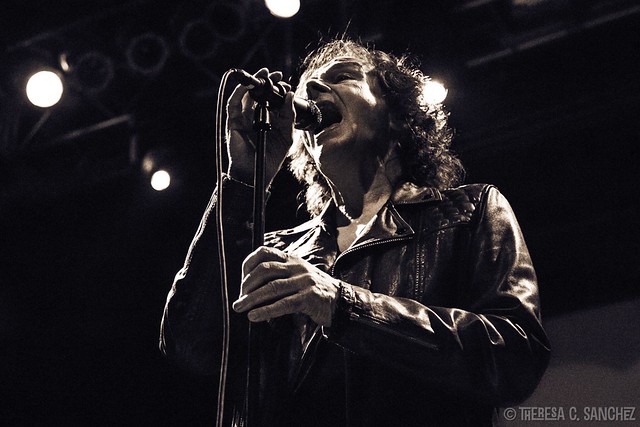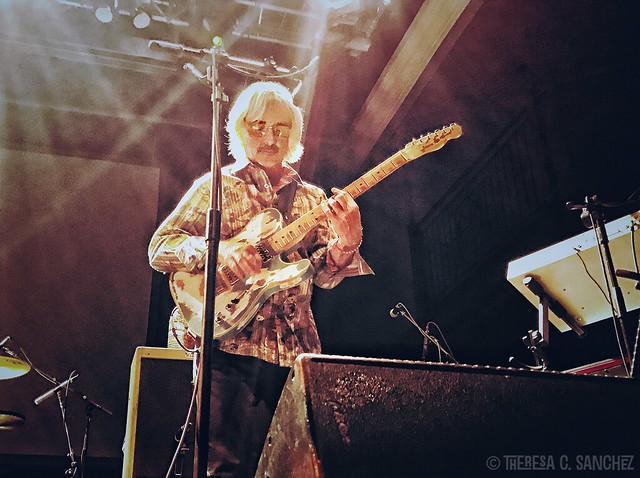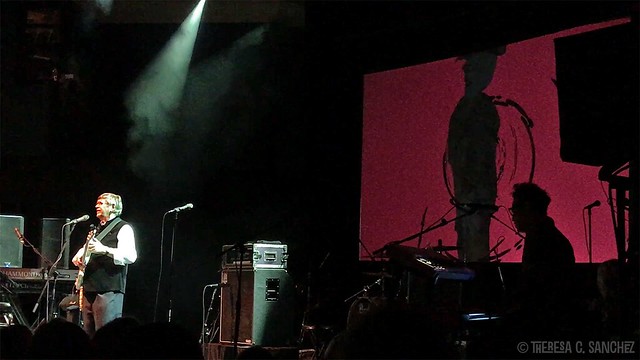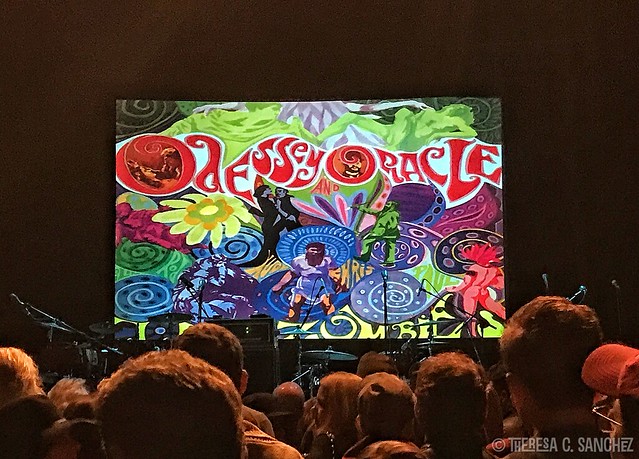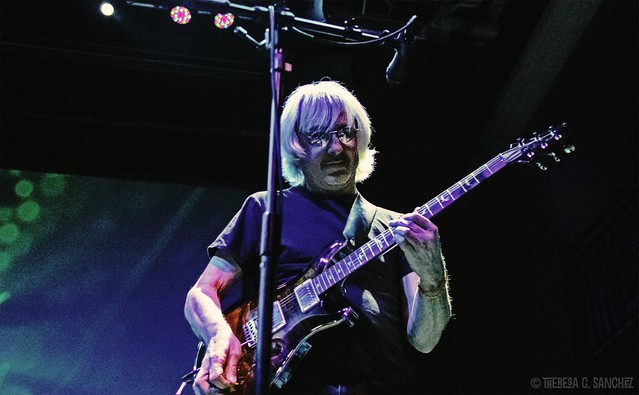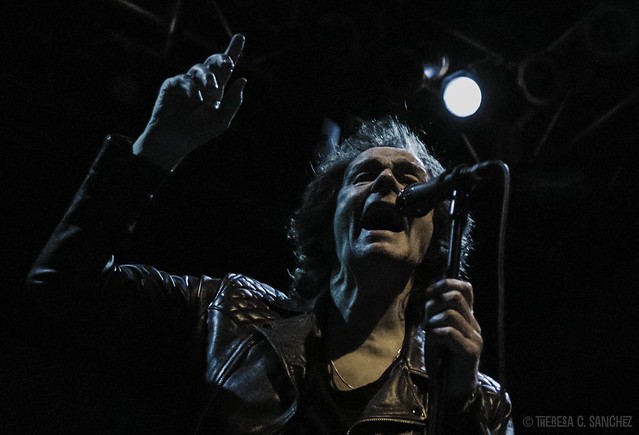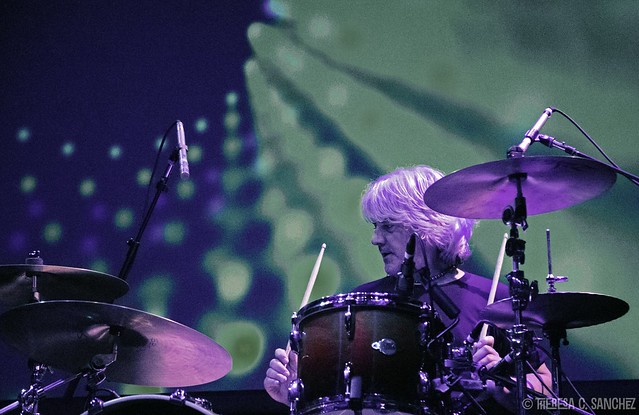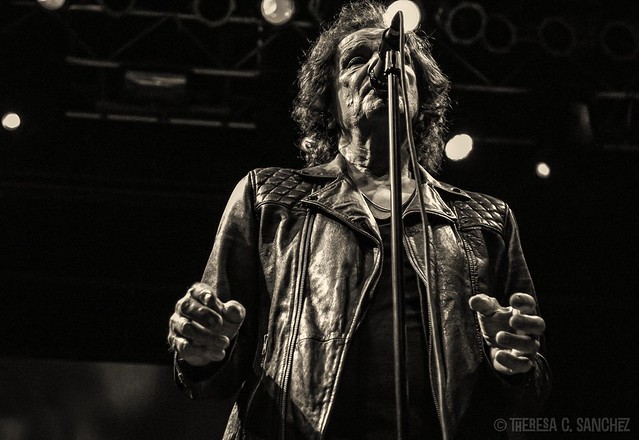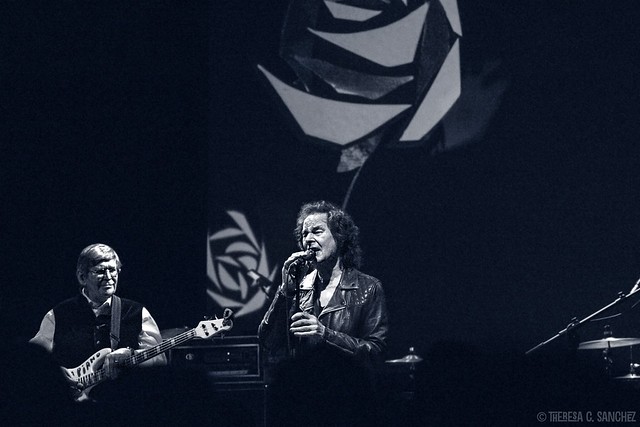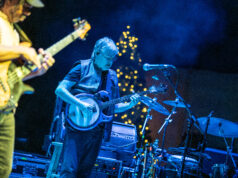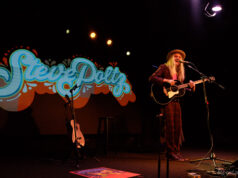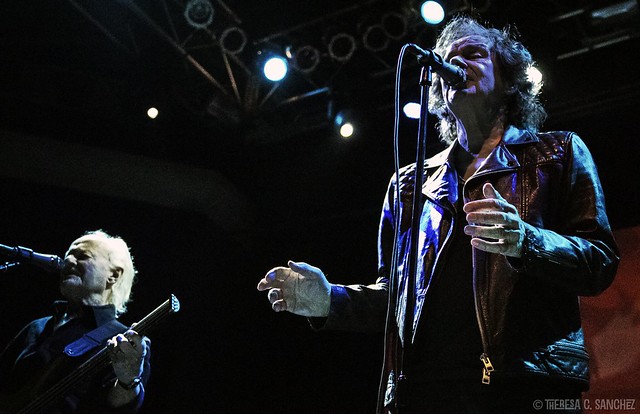
The Zombies perform at 9:30 Club on March 23, 2017. (Photo by Theresa C. Sanchez)
The Zombies Continue Banner Year
If the “Modfather” hands you one of his all-time favorite albums and tells you to listen, it would behoove you to do so.
Paul Weller helped transform the sound of British rock during the 1970s with his former punk rock-new wave band The Jam and later with The Style Council in the 1980s. When he’s not recording new music on his own (his 13th solo album “A Kind of Revolution” drops May 12) or performing live, you can find him at a record store collecting vinyl like it’s his job. His musical appetite is varied and oftentimes obscure, but always on point, so it’s no surprise a critically acclaimed commercial flop like Odessey and Oracle (misspelling courtesy artist Terry Quirk) is at the top of the tastemaker’s list.
“The first time I heard it was in the mid-70s, and it just blew my mind,” said the self-proclaimed “librarian of rock” in a 2010 BBC interview. “I hadn’t heard music like that before […] The Zombies were really unique – they had elements of jazz and classical music in their songs and songwriting. They had a very, very different sound compared to a lot of their contemporaries at the time.”
Zombies cofounder and keyboardist Rod Argent said that the group was “completely floored” by Weller’s admiration and often talks about it onstage.
“Ten years after it came out, [Weller] was No. 1 in the charts with The Jam when he said, ‘My favorite album of all time is ‘Odyssey and Oracle’,” recalled Rod during a 2016 interview following their Ramblin’ Man Fair performance. “It’s something that he still says today. He goes out – still – and buys copies of the album for people who haven’t bought it. Which is very sweet, isn’t it?”
Peer praise is even more saccharine when paired with victory – a feat that had eluded the British baroque pop quintet for many years following the chart-topping achievement of their first two hits, “She’s Not There” (1964) and “Tell Her No” (1965). Had it not been for this kind of word-of-mouth grassroots effort and the blood, sweat, and tears of legendary producer and professional musician Al Kooper (Bob Dylan’s buddy who discovered Lynyrd Skynyrd, for those keeping score), this might just be another shelved record gathering dust.
But it’s not. And here they are, celebrating the 50th anniversary of the recording of a creative masterpiece, with all the pomp and circumstance of a royal parade. The record’s golden milestone has been bolstered by several strategically scheduled offerings:
- The March 17 release of the 50th Anniversary Edition of the 1968 album, including seven unreleased alternate mixes.
- The March 30 publication of the 12″ x 12″ tome “The ‘Odessey’: The Zombies in Words and Images.”
- The April 18 premiere of an animated lyric video for the album’s first single “Care of Cell 44” (1967).
- The April 22nd release of a pair of Record Store Day exclusive limited edition 7″ singles: “A Rose for Emily” / “This Will Be Our Year” and “I Want You Back” (1965 and 2015 recordings).
- A May 1 live television performance of “Time of the Season” on Conan and later bonus web exclusive of “A Rose for Emily” (52 years after first appearing on the variety show Hullabaloo).
These little audiovisual nuggets (in addition to a second Rock and Roll Hall of Fame nomination last October) accompanied what might be the band’s largest and exhausting commemorative gesture of all — a lengthy tour, with the first 30-date North American leg culminating tonight (May 10) in Northampton, Massachusetts. It’s the final time fans will be able to witness the surviving four original members play all 12 mythical classic tracks together live (sans guitarist Paul Atkinson, who died in 2004).
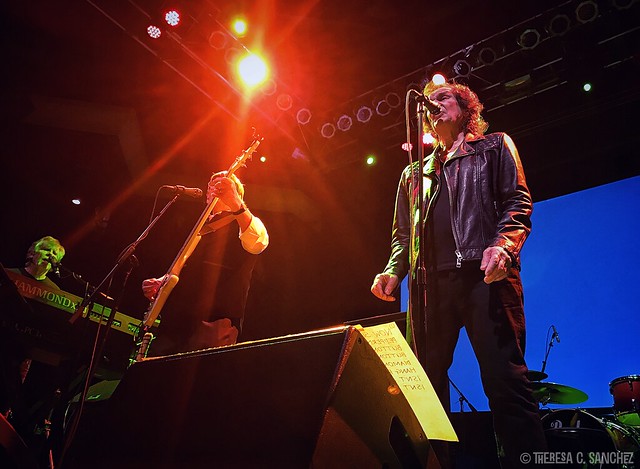 Prior to 2008, that was something that had never happened before. Due to various reasons, following their brief whirlwind 1967 Abbey Road Studios sessions, the group broke up that December. It was just four months before their first real full-length effort dropped. And for those of you who thought you might have experienced the five St. Albans boys perform in 1969, you’re sadly mistakenly.
Prior to 2008, that was something that had never happened before. Due to various reasons, following their brief whirlwind 1967 Abbey Road Studios sessions, the group broke up that December. It was just four months before their first real full-length effort dropped. And for those of you who thought you might have experienced the five St. Albans boys perform in 1969, you’re sadly mistakenly.
Their management company Delta Promotions duped American audiences with not one but *two* different imposter touring bands in a hasty effort to capitalize on the eventual success of the generational anthem “Time of the Season.” Yeah, you read that right — in fact, the Frank Beard and Dusty Hill played in a Texas-based fake Zombie group before forming ZZ Top.
The fantastical rock folklore doesn’t end there, but that’s not this post’s purpose. The Zombies graced the 9:30 Club stage March 23 with a psychedelic rock-infused, sensory-satiating 26-song set. Multiple generations of admirers converged in Washington, D.C. for this historic night of music, conveniently divided into two parts. (The Zombies return to the D.C. area on July 17 for a show at The Birchmere!)
PART I
A prerecorded introduction played overhead providing the current band lineup and other context for the night’s “musical journey.” More bands should adopt this as standard practice. Part 1 featured the current incarnation of The Zombies (Rod, lead singer Colin Blunstone, former Kinks bassist Jim Rodford, guitarist Tom Tooney, and drummer Steve Rodford). After opening with “I Love You,” Colin greeted the audience and offered a short historical anecdote (he and Rod did this throughout the show), helping inform the younger fans in attendance, while reminding older ones of what brought them there in the first place — the tunes!
“We’re going to play all sorts of obscurities and hopefully a few hit songs as well! ALL these tracks have a connection to the U.S. The first song, it actually was a hit for a band called People!, but it was written for a band named The Zombies by Chris White. The next song [“I Want You Back Again“] is the only song we recorded way back in the ’60s and then put on our most recent album [Still Got That Hunger (2015)] as a re-recorded track, because we heard a live version by Tom Petty and it was fantastic!”
Colin wasn’t kidding. Tom’s first concert adventure featured The Zombies. His May 2009 Beacon Theatre live cover with The Heartbreakers nearly transcends the original 1965 B-side. In his “very long introduction to a very short song,” Tom explained how influential the song was to his younger self.
“Riding back from their show to go home, I heard this song on the radio and it stuck with me ever since and I tracked it down. I found the song and we learned it. And then The Zombies came to see us play in England and really made us scared, you know. And they said, ‘Hell, man. You do it better than we do! But — that’s not true!’.”
Upon finishing, Rod chimed in visibly beaming with pride as he corroborated Colin’s story regarding the reimagined new album track. He shared a quick story about an unexpected phone call from Billboard while on the road in 2015 (a practice he’s done at most live shows since it happened).
“We just wanted you to know that your new album — for the first time in 50 years as The Zombies — you’re in Top 100 Album sales.”
Further investigation proved there was much more to Rod’s revelation; the group had multiple chart appearances worthy of more recognition.
- Their first single “She’s Not There” soared to No. 2 on the Billboard Hot 100 in 1964.
- They went on to have three top 10 songs on the Hot 100 over the next five years.
- Half a century later in 2015, Still Got That Hunger appeared at No. 35 on Top Rock Albums, No. 15 on Internet Albums, No. 24 on Independent Albums, No. 94 on Top Current Albums, in addition to the already noted No. 100 in Top Album Sales ranking.
- That same year (2015), Odessey and Oracle entered the Vinyl Album chart at No. 24. Prior to that, the band had not charted on an album tally since 1969’s Billboard 200.
That industry testament to the new content’s quality helped Rod segue into introducing new material — an unnecessary obstacle for many a band. “The thing is, we love playing old stuff. We obviously really do, but always in the context of being able to create and rehearse new stuff. That’s really where we get out energy from.”
They played “Moving On” and “Edge of the Rainbow” to a warm audience reception and followed with four uninterrupted 1960s hits. Their cover of Smokey Robinson & the Miracles‘ “You’ve Really Got a Hold Over Me” included vocal arrangements embodying levels of desperation other renditions lack. They further grabbed the audience’s attention with a spirited interpretation of the 1960 Bo Diddley hit “Roadrunner.” It was uncanny how similar Colin’s voice sounded like Steven Tyler’s on the opening declaratory line “I’m a roadrunner!” Upon later finding out that Aerosmith tackled the tune on their 2004 album Honkin on Bobo, it’s clear that vocal comparison wasn’t too off the wall.
The group rounded out opening set with four more songs, an encore single, a terrific tale, and a not-so-humble request. Colin, being the extraordinary raconteur that he is, spun quite the sensational yarn while describing the band’s first (and only) silver screen appearance. The late Austrian director Otto Preminger asked the band to write and record three songs in ten days for the 1965 mystery film “Bunny Lake is Missing,” featuring the late Sir Laurence Olivier and Carol Lynley.
“So we shared a scene with ‘Larry’ as I like to call him [laughs]. I never met him actually, but I’d like to call him Larry. But anyway — this scene, he’s in a pub and we come on the TV and we were– you know there was a lot of communication going on between Larry and us. We are on the TV. He gets up, he walks across the room, and he turns the TV off.”
While it might seem farfetched, most of what he said was in fact, true — except for one tiny detail. The bartender didn’t just pour drinks and settle tabs. He also manned the entertainment controls. He was the one who initially switched the channel over from the 1960s equivalent to an Amber Alert to the rockers performing “Remember You” at a concert.
While Olivier does approach the bar seeking a refill, the camera pans from him to the television without registering any kind of major interaction. The band’s total face time adds up to about 35 seconds over the course of the five and a half minute scene. Bottom line, they were granted another opportunity to reach an audience with their music — however bizarre that outlet might have been. Colin acknowledged a fan waving a vinyl copy of the film’s soundtrack before beginning “Just Out of Reach,” one of the two other overheard background tracks.
One of the show’s most memorable moments took place after all the new songs were done. Before analyzing the specifics of the prodigious prog-rock production that took place moments later, the following observation is necessary. Rod’s confidence borders cockiness at times and quite frankly, that’s to be expected when you’re a living, breathing musical genius. What sets him apart from other “rockstars” is his true love of the craft and the written word he and his bandmates bring to life daily. Given that, the request he made to the crowd before ripping into an extended version of the 1973 Argent hit “Hold Your Head Up,” wasn’t only justified, but good-natured in origin.
“If you’re going to sing with us tonight — I really hope you do — please, for God’s sake, get it right.” Now, if he didn’t have the kind of the artist-fan rapport he’s cultivated over many decades, this couldn’t have worked. But he does and it did. Once the audience finished laughing, they seemed eager and ready to get schooled on the correct lyrics. Somehow over time, the words Chris initially wrote for The Zombies, “Hold your head up, woman!” got morphed into “Hold your head up, woah.”
Once the audience confirmed they understood the line ended with “woman” and not “woah,” Rod placed his fingers on the keys and released a heavy, bass-like wave of sound that rolled over the crowd. What transpired over the next 11 minutes was undoubtedly the most epic improvisational arrangement of a song Ultimate Classic Rock lists as one of “Top 10 Organ Rock Songs” of all time. During one of his solos, Tom and Jim mimicked the signature synchronized sway and dip of the bearded Texas musicians who once pretended to be them — how meta! Rod’s effective incorporation of Bach’s classic wedding march Cantata No. 147: Jesu, Joy of Man’s toward the song’s end was pure brilliance and left many people scratching their heads wondering what they had just heard.
The show could have ended after Colin’s angelic encore — a goosebump-inducing “The Way I Feel Inside,” but the band wasn’t even far from done.
You’d never guess looking out at the three floors of adoring DC-area fans, that this band was once so desperate for work that they reluctantly agreed to a brief residency in the Philippines to make ends meet.
Once the clock struck 9:30 p.m. and the baritone narrator finished bringing the audience up to chronological speed with facts and black and white photographic throwbacks, the band returned to the stage, this time with four additional members and more instruments.
While the first hour almost resembled a laid-back episode of VH1‘s Storytellers, the second 45 minutes came across as more precise and rehearsed in the best possible way. They moved in quick succession from track to track until all songs were complete before any discussion. It’s hard to explain how 35 minutes of words and sound recorded nearly 50 years ago still have the power to affect and energize such a broad audience.
Fortunately, prior familiarity with the dozen ditties was not a prerequisite for enjoyment. They could have easily played either segment as a standalone program. You just had to be there, and if you weren’t you could’ve been, because it was surprisingly not sold out (yet another mystery on the album’s odyssey).
Before the opening notes of “Care of Cell 44” — a song Pitchfork referred to as “the sunniest song ever written about the impending release of a prison inmate” — an excited fan turned to his friend and said: “This is going to be amazing. Do you have your earplugs ready?” She responded with a nod, asserting: “This album was the late ’60s and nobody seem to know it.” The playful piano notes, “choral harmony breaks,” and clever key changes made for a strong start, which resulted in resounding applause that seemed to increase with each song.
“Hung Up On a Dream” — their “token flower power song” — commenced with spine-shivering keyboard work and featured a distinctive guitar solo.
The contemplative melody conveyed a lament-like reflection on an ephemeral moment in time stylistically specific to 1960s-era rock. Then Rod chimed in: “That’s the end of Side One,” further contributing to the night’s overall vibe of an intimate live album listening party.
“Changes” showcased Mellotron flutes and conga rhythms paired with a robust harmonizing reminiscent of The Mamas and The Papas. They followed that up with “I Want Her She Wants Me,” a positively-charged pop track ideal for head bopping. Rod sang lead and the backup vocals ascended toward the end of track, nearly lifting everyone up, carrying them happily away. The upbeat nature flowed organically into a warm execution of “This Will Be Our Year.” Colin’s controlled his vibrato as he emphatically expressed what the entire band must have been thinking: “It took a long time to come.”
The show’s tone took an eerie turn when Chris performed the historical narrative of a soldier at war known as “Butcher’s Tale (Western Front 1914).” An antique peddle organ produced the illusion of an accordion synth. Rod’s handwritten words accompanied the graphic designs of Chris’ wife, artist and singer Vivienne Boucherat on a large backdrop screen throughout that song and most of the show. “Time of the Season” incorporated an extended keyboard solo and an interactive call and response with the audience.
The band’s energy reached an electrifying climax with the final encore — an extended reprisal of “She’s Not There.” But before that “monster jam session” could ensue, Rod explained the show’s intent: “When we decided to do this, we said, ‘Well, there is only one way we’re going to [tour], and that is if we reproduce every single note that was on the original album.’ And it happened!”
Hoots and hollers abounded as he then provided heartfelt introductions of each troupe member. “When we recorded the original album, we had more tracks than we were used to, so we were putting overdubbed sections [into it]. Obviously five people can’t just do that all — so we enlisted the help of people we could not do without! There’s nothing there that wasn’t there originally.”
Darian Sahanaja – a.k.a. “Brian Wilson‘s secret weapon” — sang harmonies and used a Memotron to recreate a lot of the record’s Mellotron sections. ‘Viv’ Boucherat was recognized for her high falsetto parts and the “absolutely beautiful” art she produced for the band’s aforementioned book. The late Paul Atkinson was remembered for his formative efforts before Rod looked ahead:
“We’ve never been people who want to look backwards all the time, as you know. We will continue to play some of the things we can do with just five people. Doing the whole thing from start to finish? This is the last chance that people will get to see this because we’re not going to [do it again live] after this year. This is a really sentimental reunion and it feels as if we finished that 1965 tour yesterday with Chris White and [drummer] Hugh Grundy.”
Their auditory wave goodbye included three extra minutes of improvised guitars, drums, and keys. At one point Rod even expertly wove in part of Chicago‘s 1969 percussive hit “I’m A Man” because you know, when you’re the first major artist to tour with a Hammond Xk-5 organ, you can do that sort of thing. Upon completion, they thanked the audience and joined together for a final bow and gratuitous waving before departing the stage on either side. Atkinson’s image appeared on the screen in tribute. The Zombies were no longer there.
FAN FAVES
Mark Peria of Annapolis, Maryland, first heard Odessey and Oracle when he was about 8-years old hanging out at the studio where his uncle used to work. He acknowledged having noticed an increase in the album’s airplay over the past months and that the concert was more “nostalgic” than anything. “I haven’t listened to the album in its entirety in so long and to see it played live was so awesome.” He made it a point to catch their 9:30 Club show since missing the band play closer to him at Rams Head Onstage in June 2013 and May 2016.
His top band track happens to be one of his overall favorite song, “This Will Be Our Year.” He really thought Colin belted out the song he finds synonymous with sweetness and optimism. “If I find a girl that would like that to be her wedding song, I’d marry the her on the spot.”
PARTING THOUGHTS
Some could say The Zombies have become the personification of that time-honored melody. Would it be too cliché to acknowledge that the past 365 days have certainly been the band’s long-overdue “year”? Yes — but better late than never.
To take the parallels a step further, one need look no further than the Bible. An oft-recited verse can be heard at many of the same weddings requesting the above two-minute tune. “To every thing there is a season, and a time to every purpose under the heaven,” [Ecclesiastes 3:1] It took some time and space, but this band’s time has finally arrived and they’re squeezing every last breath possible from this resurrected LP while they can. I don’t blame them. They deserve it.
Now that Record Store Day is over (the most successful to date, with sales up 213 percent), vinyl detectives can return to their respective independent wax purveyors without fear of lengthy lines. Be sure to look for the group’s most recent catalog contributions. And if you happen to rub shoulders with Paul Weller as you flip through the stacks (highly plausible closer to October 7), you best have Odessey and Oracle in your bag. But who knows? If you don’t, there’s always the chance he’ll grab a copy for you!
Until then, happy hunting. And remember The Zombies return to the area July 17 to perform with Don DiLego at The Birchmere in Alexandria, Virginia.
BAND TRIVIA
- The band was first called “The Mustangs,” but that was scrapped after learning there were multiple musical groups with the same moniker. According to Rod, the band’s first bassist Paul Arnold suggested the name. “It wasn’t that I knew the definition of a zombie, I just liked the sound of the word,” said Paul in 2007. He left the band after six months to become a doctor.
- The group earned their first recording contract in 1964 with Decca Records after winning a local Herts Beat talent contest sponsored by the London Evening Standard.
- “She’s Not There” was the second song Rod ever wrote. “With the sort of arrogance of youth, I thought, ‘Yeah! I’m going to write a song that’s as good as The Beatles.’ I didn’t see any of the pitfalls. You know, I thought, we’ll go into the studio, we’ll record it, and it will sound fantastic. Colin will sing it great. It will all sound great. It will come out and be a hit and it was, which was extraordinary, but it didn’t surprise me at the time,” he said in a Dutch documentary.
- The incomparable producer, A&R executive, and music industry powerhouse that is Clive Davis passed on Odessey and Oracle, while serving as president of Columbia Records. It took Al’s aforementioned championing to get any airplay. I guess you can’t be “right” all the time!
- “Time of the Season” is the direct result of a misunderstood Smokey Robinson & The Miracles lyric. Rod blames the misheard verse of “The Tracks of My Tears” (1965) on the small gramophones he played music on. “For years I though the song was ‘It’s the time of the season to trace the tracks of my tears,’ rather than ‘If you look closer it’s easier to trace the track of my tears’.” And while disappointment upon finally discovering the real words, he decided to write a song using those for four words,” he said in a 2017 People interview.
- The Zombies used John Lennon‘s Mellotron for a large portion of instrumental sound creation because The Beatles had left it in the studio after finishing Sgt. Pepper’s Lonely Heart Club Band. They were on a very tight budget and Rod used it because “it was there.”
- Odessey and Oracle ranks 100 out of Rolling Stone‘s Top 500 Albums of All Time (as of May 2012).
- This full-album concert concept wasn’t a first, however. The Zombies did a sold-out three-show run for the record’s 40th anniversary in March 2008 at Shepherd’s Bush Empire in London (one night was recorded, filmed, and released as Odessey and Oracle (Revisited). Riding on the success of that initial reunion, they played a mini four-date British tour in 2009 and a longer American tour in 2015.
The Zombies return to the D.C. metro area to perform at The Birchmere on Monday, July 17. Buy your tickets online.

